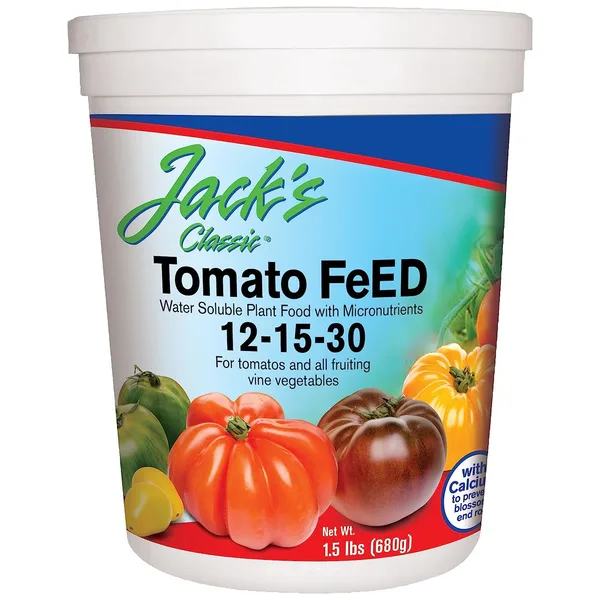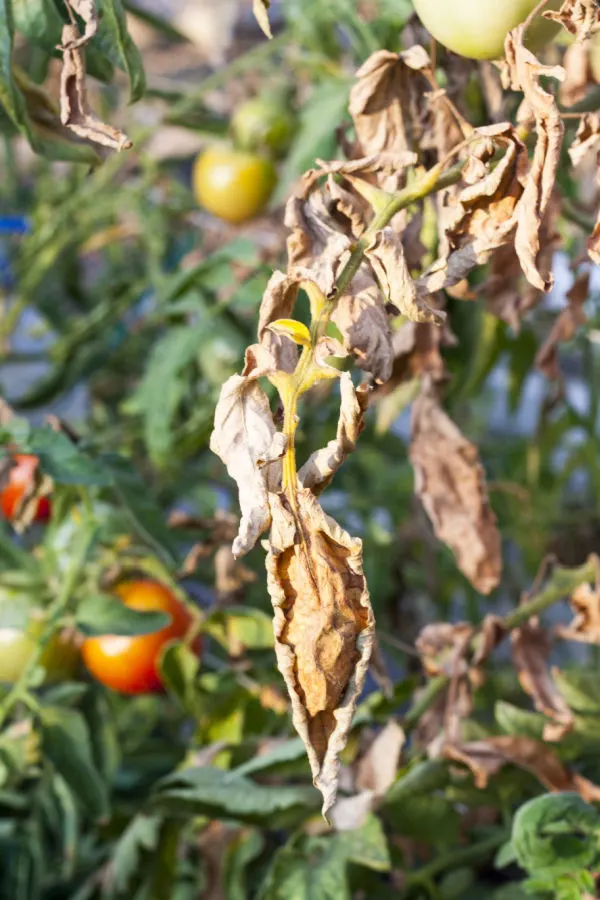Are the leaves on your tomato plants turning brown? As summer hits full stride and tomato season gets into full swing, many gardeners get worried when some of the leaves on their tomato plants begin turning brown – and in some cases – even begin to die and fall off.
This can be especially true for the lower leaves of tomato plants in mid to late summer. Quite often, when a plant has any issue at all – it will show up first on the lowest leaves. And if the issue is serious enough – it then spreads to the rest of the plant.
One thing is for sure, for tomato growers, the last thing they want is trouble with their plants after nurturing them all spring and early summer. Especially now that they have finally matured enough to start producing a harvest!

Are Your Tomato Leaves Turning Brown?
Why The Leaves On Tomato Plants Turn Brown
So what is the cause? Could it be a lack of water or nutrients? Maybe the start of the dreaded tomato blight or another tomato disease? Or could it be an invasion of pests trying to mount an attack on your plants?
The truth is, there can be a lot of reasons the leaves of a tomato plant start to fail or fade in mid summer. As you will see below, late season blight is certainly a major culprit for the failure of many late season tomato plants. So is a lack of nutrients. But surprisingly, in other cases – the plant dying back is completely natural.
So before you begin to think your tomato crop might be in serious jeopardy, here are a few important things to know about how your tomato plants grow in mid to late summer – and how those yellowing or browning leaves might not be the end of the road for your plants – or your tomato harvest.
When Tomatoes Don’t Get Enough Nutrients
One of the biggest reasons tomato plants suffer in the summer is from a lack of nutrients. Tomato plants are heavy feeders. Because of that, they can quickly use up the available nutrients in the soil. And when they do, the leaves and the plant can begin to suffer.
Summer fertilizing is vital to keep your plants strong, healthy and producing. Fertilize your plants every seven to ten days with a liquid fertilizer that has more phosphorus and potassium than nitrogen. This will help it continue producing blooms and fruit, and not just green up the foliage. Affiliate Link: Jack’s Classic Tomato Feed Fertilizer

When fertilizing, give your plants half of the recommended dose by diluting the mix in half. This allows you to feed more often, but with a steady supply of power for your plants.
When A Lack Of Water Becomes An Issue
Another big reason tomato plants suffer in mid summer and their leaves turn brown is from either too much or too little water. Tomato plants need between 1 and 1.5 inches of rain weekly. If it’s not falling from the sky, watering is vital to keep the foliage strong and the plant producing.
More than anything else, keep plants watered during extended dry periods. When watering, water deeply and not just for a few minutes at the surface. This will help the plant grow its roots deeper, protecting them from drying out easily.
Avoid Fruit Overload
So what if you are growing indeterminate tomatoes and still having a problem with your plants not producing more and starting to look weak? In some cases, your plant might be suffering from fruit overload.
If you allow too many tomatoes on a plant at once, it will cause the plant to stop producing. This is called fruit overload and is common not just on tomato plants, but on many vegetable plants.
Listen In Below To Our Podcast On Feeding Tomatoes For Success!
Tomato plants should be harvested often in the growing season. This will keep the plant’s energy on growing and producing. And don’t worry if those tomatoes are not fully ripe. As it turns out, it is better to pick tomatoes as they barely start to turn and let them ripen off the vine!
Late Season Blight
Tomato blight is certainly a big issue for many tomato plants in late summer. Although blight can occur at any point in the growing season, it is most prevalent near the end of the growing season.
Tomato blight is a spore disease that infects the soil and plants. The spores can spread quickly via the wind, especially as plants grow larger late in the season. Although dying, browning foliage is a symptom, the real tell-tale sign of tomato blight is greasy, oily spots appearing on your tomatoes. When you see this, it is definitely time to pull the plants.

Tomato blight is highly contagious, and controlling it as quickly as possible is extremely important. Do not compost the plants, but instead burn or discard them. In addition, locate next year’s plants as far from the space as possible. For more, see: What To Do If Your Tomato Plants Show Signs Of Blight – Why & How To Act Fast!
Determinate vs. Indeterminate Tomatoes
Last but not least, in some cases, the reason a tomato plant’s leaves may be yellowing and dying off can be 100 percent natural. Why would a tomato plant suddenly begin to die in the middle of summer? Because it may be a determinate tomato!
Tomatoes are either determinate, or indeterminate. Indeterminate tomatoes will grow and produce until killed off by a frost or a freeze. But determinate varieties of tomatoes have a set life span. They produce their entire crop over a three to four week period, and then quickly die off.
A great example of this is with the Roma tomato. Roma tomatoes are quite popular among home gardeners. But Roma tomatoes are determinate plants. So after their main crop has ripened, they will die off – no matter what.

Unfortunately, this plant is often mistaken every year by gardeners as having a late season issue – when in reality, it has simply run its course. So before you think your plant may be in trouble, check to see if it might just be a determinate variety.
Here is to keeping your tomatoes producing this year – and to a great harvest right up until late fall. And if your tomato leaves are turning brown – to finding out why and fixing the issue fast!
This Is My Garden
Follow Our Facebook Page For Great Gardening Tips And Advice! This Is My Garden Facebook Page
This Is My Garden is a garden website created by gardeners, for gardeners. Jim and Mary Competti have been writing gardening, DIY and recipe articles and books and speaking for over 15 years from their 46 acre Ohio farm. They publish three articles every week, 52 weeks a year. Sign up today to follow via email, or follow along!
